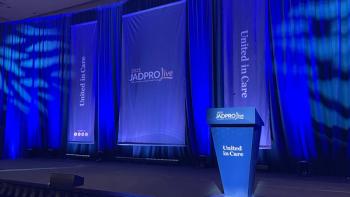
Sacituzumab Govitecan Beats All Chemo Regimens in TNBC Treatment
Sacituzumab govitecan, an antibody drug conjugate, maintained survival and response benefits over chemotherapy regimens.
Sacituzumab govitecan, an antibody drug conjugate, maintained progression-free survival (PFS), overall survival (OS), and response benefits over chemotherapy regimens, regardless of the agents used, according to data from a subanalysis of the phase 3 ASCENT trial (NCT02574455), presented during the 2021 ASCO Annual Meeting.1
Sacituzumab govitecan resulted in a longer median PFS compared with any of the physician’s choice chemotherapy options, which included eribulin, vinorelbine, capecitabine, or gemcitabine (HR, 0.41; 95% CI, 0.32-0.52; P <.001). The median PFS, by blinded independent central review, was 5.6 months (95% CI, 4.3-6.3) with the ADC, 2.1 months (95% CI, 1.5-2.8) with eribulin, 1.6 months (95% CI, 1.4-2.7) with vinorelbine, 1.6 months (95% CI, 1.4-2.4) with capecitabine, and 2.7 months (95% CI, 1.6-4.8) with gemcitabine.
The ADC also prolonged the median OS over eribulin, vinorelbine, capecitabine, or gemcitabine, at 12.1 months (95% CI, 10.7-14.0) vs 6.9 months (95% CI, 5.8-7.8), 5.9 months (95% CI, 4.5-6.7), 5.2 months (95% CI, 3.5-8.6), and 8.4 months (95% CI, 5.0-9.6), respectively (HR, 0.48; 95% CI, 0.38-0.59; P <.001). Sacituzumab govitecan elicited an ORR of 35% vs 5%, 4%, 6%, and 3% with eribulin, vinorelbine, capecitabine, or gemcitabine, respectively.
“The efficacy benefit for median PFS, median OS, and ORR with sacituzumab govitecan vs single-agent chemotherapy in the second-line or greater metastatic TNBC setting in ASCENT was retained when evaluating each chemotherapy agent individually,” Joyce A. O’Shaughnessy, MD, lead study author, cochair of Breast Cancer Research and chair of breast cancer prevention research at Baylor-Sammons Cancer Center of Texas Oncology, said in a poster presentation on the data. “These results confirm that sacituzumab govitecan should be considered as a new standard of care in this patient population.”
For patients with previously treated TNBC, standard treatment has comprised single-agent chemotherapy; however, this approach has been linked with responses rates of under 20% and a short PFS ranging from just 2 to 3 months. Eribulin is a frequently used agent in this population, but median PFS continues to be poor, at less than 3 months.
Sacituzumab govitecan is comprised of a Trop-2 antibody that is paired with SN-38 through a proprietary hydrolysable linker. The agent is unique from other available ADCs in that the antibody is highly specific for Trop-2 and it has a high drug-to-antibody ratio of 7:6:1. Moreover, internalization and enzymatic cleavage by tumor cell is not needed to free SN-38 from the antibody. Notably, the ADC also has a bystander effect because hydrolysis of the linker releases SN-38 extracellularly in the tumor microenvironment.
In April 2021, the FDA granted a full approval to sacituzumab govitecan for the treatment of patients with unresectable locally advanced or metastatic TNBC who have received 2 or more prior systemic therapies, at least 1 of them for metastatic disease. The regulatory decision was based on earlier data from ASCENT, which showed that the agent significantly improved survival over physician’s choice of single-agent chemotherapy in patients with metastatic TNBC who were receiving treatment in the second- or later-line setting.2
Earlier data from the trial showed that the median PFS with the ADC was 5.6 months (95% CI, 4.3-6.3) vs 1.7 months (95% CI, 1.5-2.6) with chemotherapy (HR, 0.41; 95% CI, 0.32-0.52; P <.001). Moreover, the median OS in the investigative and control arms was 12.1 months (95% CI, 10.7-14.0) and 6.7 months (95% CI, 5.8-7.7), respectively (HR, 0.48; 95% CI, 0.38-0.59; P <.001).
In the subanalysis presented during the meeting, investigators evaluated the safety and efficacy of sacituzumab govitecan vs each chemotherapy agent to determine how each drug performed individually.
Of the 529 patients enrolled to the phase 3 study, 235 patients in the ADC arm were negative from brain metastases, as were 233 patients in the chemotherapy arm. In the control arm, eribulin was noted to be the most frequently selected agent (n = 126), followed by vinorelbine (n = 47), capecitabine (n = 31), and gemcitabine (n = 29).
At the time of data cutoff, 6% (n = 15) of those on the sacituzumab govitecan arm remained on treatment vs 0% of those on the chemotherapy arm. The most frequently reported reasons for study discontinuation included disease progression and withdrawn consent.
Across the arms, the majority of patients were female, and the median age ranged from 50 years to 56 years. The majority of patients were White, had an ECOG performance status of 1, and received more than 3 prior lines of chemotherapy. The median number of prior anticancer regimens received ranged from 3 to 5 lines.
Additional data showed that of those who responded to treatment with sacituzumab govitecan, the complete response (CR) rate was 4% and the partial response (PR) rate was 31%. The clinical benefit rate achieved with the ADC was 45% vs 8% with eribulin, 6% with vinorelbine, 10% with capecitabine, and 14% with gemcitabine. The median duration of response across these subsets was 6.3 months (95% CI, 5.5-9.0), 3.6 months (95% CI, 2.9-4.2), 2.8 months (not evaluable [NE]), NE, and 2.9 months (NE), respectively.
Regarding safety, key treatment-related adverse effects (TRAEs) that were grade 3 or higher in severity experienced with the ADC vs eribulin comprised neutropenia (51% vs 31%), leukopenia (10% vs 5%), diarrhea (10% vs 0%), anemia (8% vs 2%), febrile neutropenia (6% vs 2%), fatigue (3% vs 5%), and peripheral neuropathy (0% vs 2%).
Important grade 3 or higher TRAEs reported with sacituzumab govitecan vs vinorelbine, capecitabine, and gemcitabine combined included neutropenia (51% vs 36%), leukopenia (10% vs 6%), diarrhea (10% vs 1%), anemia (8% vs 8%), febrile neutropenia (6% vs 2%), and fatigue (3% vs 6%).
Additionally, treatment-emergent AEs resulted in discontinuation in 5% of those who received sacituzumab govitecan, 2% of those given eribulin, 10% of those who received vinorelbine, 7% of those given capecitabine, and 9% of those who were administered gemcitabine. Only 1 treatment-related death was reported in the chemotherapy arm; this patient received eribulin and had died from neutropenia sepsis. Notably, no treatment-related deaths occurred with the ADC.
“The safety profile of sacituzumab govitecan vs single-agent chemotherapy in the second-line or greater metastatic TNBC setting in ASCENT was comparable,” O’Shaughnessy concluded.
References
- O’Shaughnessy J, Punie K, Oliveira M, et al. Assessment of sacituzumab govitecan (SG) versus treatment of physician’s choice (TPC) cohort by agent in the phase 3 ASCENT study of patients (pts) with metastatic triple-negative breast cancer (mTNBC). J Clin Oncol. 2021;39(suppl 15):1077. doi:10.1200/JCO.2021.39.15_suppl.1077
- Bardia A, Hurvitz SA, Tolaney SM, et al. Sacituzumab govitecan in metastatic triple-negative breast cancer. N Engl J Med. 2021;384(16):1529-1541. doi:10.1056/NEJMoa2028485
Newsletter
Knowledge is power. Don’t miss the most recent breakthroughs in cancer care.

















































































